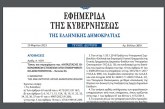
Greece: Achievements, challenges, risks and a strategy for the future
Rebalancing and adjustment of the economy from 2009 to 2017
The progress made since the beginning of the debt crisis in 2009 is remarkable and unprecedented by international standards. More specifically, Greece achieved:
• The full elimination of the twin deficits, i.e. the very high fiscal deficit and the large current account deficit.
• The full recouping of competitiveness in terms of labour costs and its considerable improvement in terms of prices. It is worth noting that this was achieved through a painful process of internal devaluation, involving significant reductions in nominal wages and salaries, mainly in the private sector.
• At the same time, a bold reform, privatisation and economic modernisation programme is being implemented in areas such as the labour and product markets, the healthcare and social security systems, the fiscal framework, the tax system and public administration. (However, there has been considerable backtracking, according to World Bank indices, regarding the rule of law, the quality of governance and institutions.)
• As a result of all these major reforms during the eight years of the crisis, the economy has become more extrovert and the production model has begun to rebalance towards export-oriented sectors.
• Finally, the restructuring and consolidation of the banking system, characterised first and foremost by significant recapitalisation, following stringent stress tests and in-depth asset quality reviews, ensure high capital adequacy ratios (Common Equity Tier 1-CET1), higher than the European average, which, along with a satisfactory NPE coverage ratio, enable Greek banks to effectively manage their high stock of NPEs.
It should however be noted that, despite the progress made, the crisis has had significant costs in terms of output and employment losses and a marked decline in household wealth. Between 2008 and 2016, Greece lost over one fourth of its GDP at constant prices, and unemployment rose by nearly 16 percentage points. Furthermore, per capita GDP in purchasing power parity in 2016 came to merely 68% of the EU average, down from 93% in 2008. Meanwhile, a large brain drain has taken place, depriving Greece’s society and economy of one of its productive parts, with devastating demographic, economic and social consequences.
Challenges Ahead
(a) Public debt sustainability
The high level of public debt feeds uncertainty, undermines confidence in the prospects of the economy, weighs on Greece’s credit rating and hinders the smooth exit from the current programme.
The debt sustainability report by the institutions and the adoption of the medium-term debt restructuring measures by the Eurogroup need to be made as soon and as clearly as possible, so as to further strengthen financial markets’ confidence and ensure a smooth exit from the programme.
(b) Consolidating confidence
In order to ensure its return to the markets on favourable terms, Greece must consolidate investor confidence in the continuation of reforms and convince that fiscal policy will not relapse once again in the wrong direction. The commitments made must be kept and decisive steps must be taken to continue reforms and privatisations, starting with the removal of obstacles to large investment projects that have already been agreed to, but are lagging. Land-use legislation should play an important role in this area.
(c) A smooth return to the markets
After the end of the programme, Greece will have to secure the funds required to cover its financing needs by resorting to international financial markets on sustainable terms. As already mentioned, the consolidation of confidence is a sine qua non. At the same time however, a financial safety net will need to be put in place to assure that Greece is able to weather adverse developments that could temporarily drive borrowing costs up to unsustainable levels.
The envisaged “cash buffer” is one such safety net, that would enable Greece to avoid a recourse to the markets at times of heightened volatility and high refinancing costs. This cash buffer is currently being built up with the trial bond issues before the end of the programme, as well as with disbursements from the European Stability Mechanism (ESM).
However, episodes of financial markets turmoil such as the recent ones appear to have a greater impact on countries with poor credit ratings and a weaker economy. These countries saw the yields on their government bonds rise considerably. This suggests that, in the present uncertain conditions, the Greek State’s return to the markets, as necessary as it may be for a return to normality, must proceed with caution.
International experience has shown that trial bond issues for the purpose of creating a sound cash buffer prior to the expiry of a programme helps bolster confidence and paves the way to the exit from the programme.
Nevertheless, the need for a complementary precautionary assistance programme should not be neglected. The possibility of a recourse to a precautionary support programme, especially if financial market conditions call for one, must not be overdramatised, as the European mechanisms are there to be used if needed. Such a precautionary assistance framework can be expected to support the Greek economy, by helping to reduce borrowing costs, since it will provide assurance of the Greek government’s and banks’ access to funding beyond the end of the current programme in August 2018. Under an ESM precautionary credit line, funds would become available, without necessarily having to be raised beforehand, whereas the build-up of a cash buffer necessarily entails additional borrowing, which would increase the annual debt service costs. Moreover, this precautionary financial assistance framework would ensure that the waiver on Greek government bonds stays in place, so that the latter remain eligible as collateral in Eurosystem monetary policy operations until Greece regains an investment grade credit rating.
Furthermore, in such case, the buffer for systemic banks should remain available beyond August 2018. Finally, the maintenance of the waiver, along with the debt sustainability measures, would enable the purchase of Greek government bonds by the European Central Bank under its public sector purchase programme either in its regular duration or during the reinvestment period, thereby exerting a downward effect on the borrowing costs of Greek government.
(d) The post-programme surveillance framework
According to the European institutional framework, the end of the Greek programme in August 2018 does not relieve Greece of its obligations vis-à-vis its lenders. What changes is the form of the surveillance framework for Greece, which must conform to the general surveillance terms and regulations in force in the European Union.
Regulation (EU) No. 472/2013 of the European Parliament and of the Council provides for automatic post-programme surveillance until the country repays 75% of the loans it has obtained from other Member States, the European Financial Stability Fund (EFSF) and the European Stability Mechanism (ESM). Furthermore, the European Commission reserves the right to subject a Member State to enhanced surveillance, if it judges that this is warranted by the circumstances.
Apart from these provisions, already in force, the European Commission has proposed changes to the economic governance of the euro area, some of which could be relevant for the type of post-programme surveillance that the Greek economy would be subject to, and will be discussed by the European Council within the first half of 2018. The aspects of potential relevance to Greece concern the enhanced role of the ESM and the possible support to Member States for the implementation of structural reforms.
Therefore, it is clear that Greece’s smooth exit from the programme and its successful course in new post-crisis European normality entail a commitment to safeguard the achievements made so far, to pursue sound economic policies and to continue and complete the structural reforms.
(e) Banks – Non-performing loans
The effective management of NPEs is the most crucial legacy problem that banks now have to tackle, if they are to fully consolidate their loan portfolios and become capable of increasing their lending. In the period immediately ahead, banks must step up their efforts to attain their NPE operational targets. The targets for the next two years are high and ambitious, yet feasible, now that the economy has returned to positive growth. Banks must, as soon as possible, broaden the scope of workouts offered to borrowers and move towards more drastic decisions, in particular with respect to the restructuring of viable businesses, the conclusion of multi-creditor workouts, the identification of strategic defaulters and the implementation of definitive solutions in the case of non-viable businesses.
Banks are facing new challenges in 2018, most notably the implementation of International Financial Reporting Standard 9 (IFRS 9), the stricter treatment of loan-loss provisions for new NPEs, as well as the EU-wide stress test to be conducted by the ECB.
Risks and sources of uncertainty
Despite the progress made so far, as reflected in key economic indicators, domestic and external risks remain, which could jeopardise the course of the Greek economy.
In the short term, the main risks relate to a delayed implementation of the measures agreed in the third review, which would in turn delay the completion of the fourth and last review of the current programme, as well as to an underachievement of the fiscal targets. In addition, the absence of a timely specification of the debt relief measures could rekindle uncertainties.
Equally significant is the risk of a serious and sustainable reversal of the Greek government bond yields. Considering that the yield on the 10-year Greek government bond was yesterday 4.48%, compared with 1.93% for the Portuguese and Italian counterparts, the risk to the debt dynamics is all too clear.
There are also external risks, which give rise to concerns about the preservation of the very favourable global economic conjuncture and global stability. More specifically, some of the matters pending at the EU level that could hinder the smooth development of the EU economy are: the Brexit preparations after the agreement of 15 December 2017 for an orderly exit, and the need to reach a mutually acceptable agreement on how to address the refugee crisis ahead of the revision of the Dublin Regulation in June 2018. Furthermore, at the euro area level, significant changes to its architecture are expected to be carried out this year, such as the setting up of the European Monetary Fund and the completion of the banking union. Any delays to the scheduled changes could stoke uncertainties. Turning to the global level, the deterioration of relations between the United States and both North Korea and Iran has given rise to turmoil. Finally, the surge of populism in several countries across the globe erodes public trust in democratic institutions and the rule of law.
A strategy for sustainable growth
Today, Greece faces the historic challenge of returning to normality and to a path of convergence with its European partners. A return to strong economic growth calls for maintaining and implementing the structural reforms already legislated, as well as further crucial reforms in areas still lagging behind, such as the tax system, public administration, the judicial system and the goods and services markets. For all of the above to materialise and for Greece to once again become a friendly place for doing business and an attractive destination for productive investment, the end of the current adjustment programme will have to mark the launch of a comprehensive national plan of economic restructuring, whose authorship and ownership will lie with the Greek government. Economic policy for the ‘day after’ Greece’s exit from the economic adjustment programmes will have to focus not only on actions to smooth out cyclical shocks, but also, and more importantly, on a medium-to-long-term growth policy geared towards the dual goal of fully utilising the economy’s productive potential and safeguarding fiscal stability.
This plan must aim for high and sustainable growth rates by encouraging private initiative, extroversion and broader social engagement. The success of such a plan will require radical changes in the fabric of the economy. The implementation of these changes requires effective and broader consensus and consultation across all social groups as well as across European-oriented political forces in the country. Today, at this critical juncture for the Greek economy, it is important to avoid a halt of the positive momentum or, worse yet, a situation where the lack of social consensus or a polarised political climate could jeopardise what has been achieved after nine years of great sacrifices. More specifically, what is needed is:
First, a drastic overhaul of public administration with clear delimitation of state intervention in private initiative. The state’s role should be to regulate the institutional framework governing the private economy and provide oversight of performance and monitoring capacity rather than acting as an entrepreneur-producer. Furthermore, the use of public-private partnerships in a wide range of administrative procedures and in the delivery of public services would shift costs from taxpayers onto users, while at the same time enabling care to be taken to support the weaker groups of the population.
Second, speeding up the privatisation programme and the development of public property. With government intervention under the new productive model being limited to the role of overseer-regulator, privatisations will increase public revenue, while also strengthening competition to the benefit of the consumer.
Third, changes in the tax system with a view to creating a clear and stable tax regime with lower tax rates for households and businesses and to broadening the tax base.
Fourth, expanding the use of electronic transactions to all types of economic activity, so as to effectively reduce the informal economy and increase public revenue with a fairer distribution of the tax burden. The success of this endeavour will crucially hinge upon citizens’ familiarisation with digital technology applications, as well as upon building a taxpaying culture.
Fifth, emphasis on the “knowledge triangle” (education-research-innovation), with evaluation of higher education and linking research to funding and to the production process. This is so because linking higher education with the production process promotes innovation and the country’s competitive advantages.
Sixth, and most important, strengthening the operational independence of key institutions and the rule of law. For this to become possible, society and the political forces must understand that strong and sound inclusive institutions, which do not serve the interests of specific groups at the expense of others, promote the welfare of society as a whole. For the restart of the economy to be a success, the status of institutions – which is synonymous of confidence –needs to be elevated in future. Weak and closed institutions generate uncertainty and disorientation, whereas strong, open and socially accepted institutions are necessary for a return to normality.



